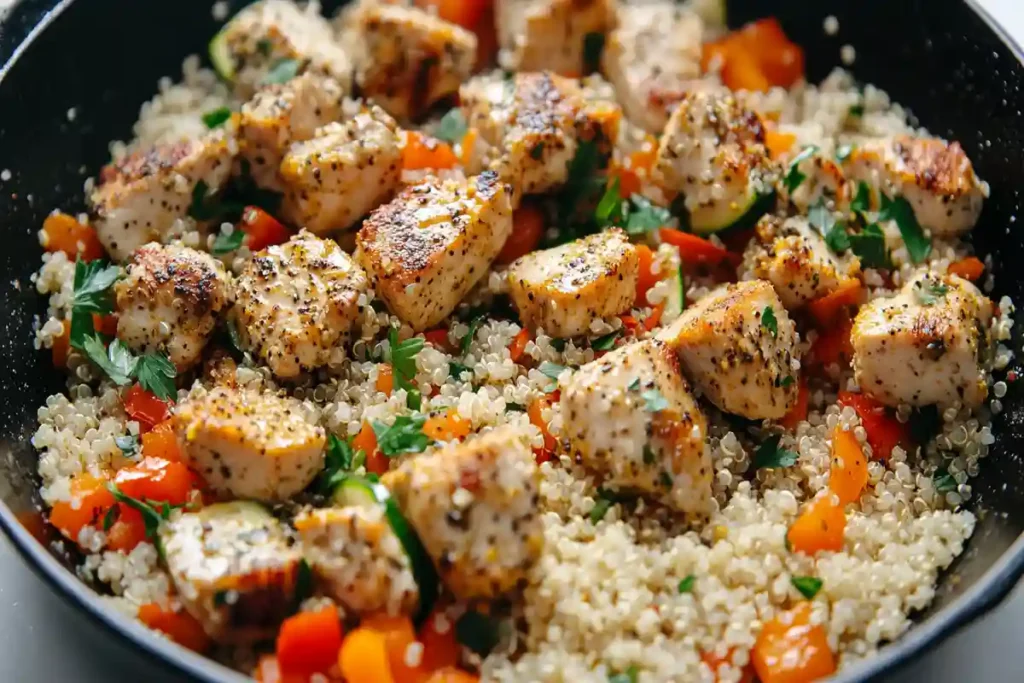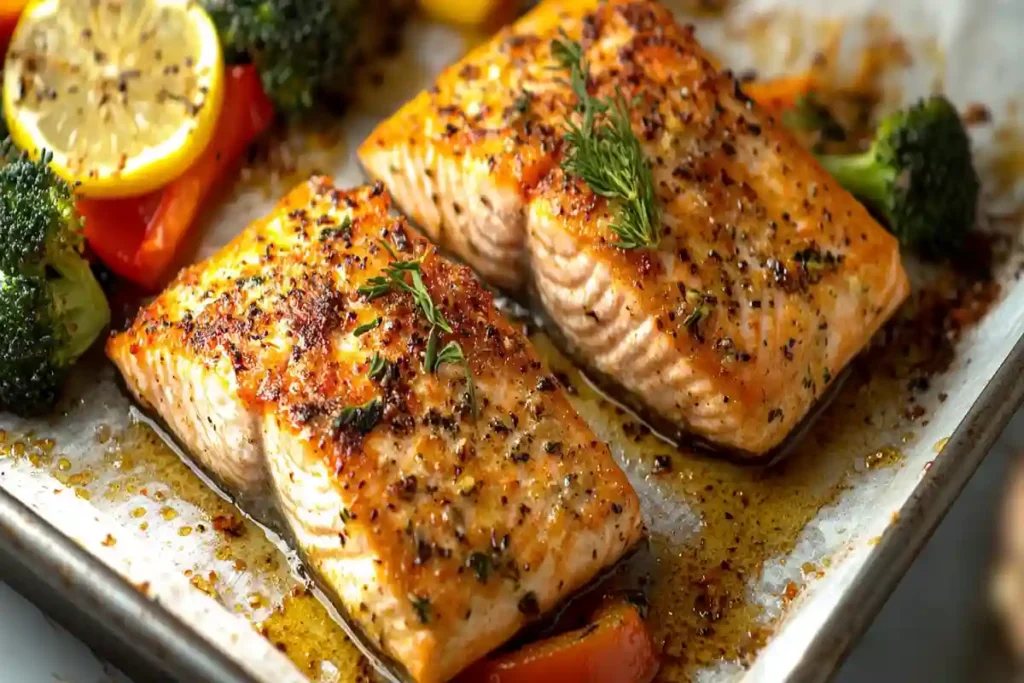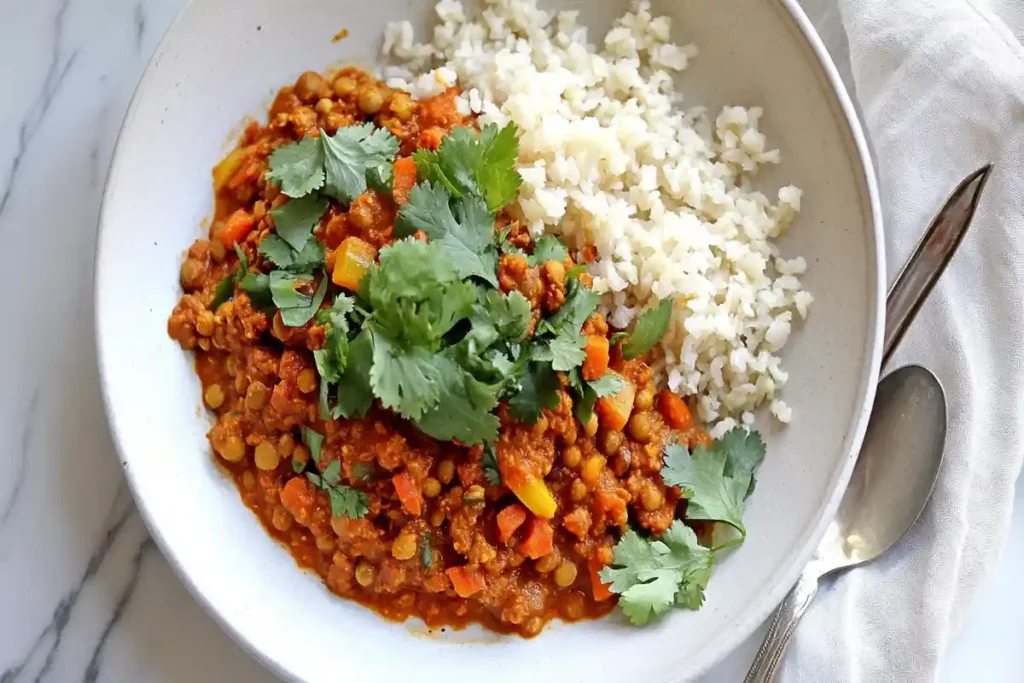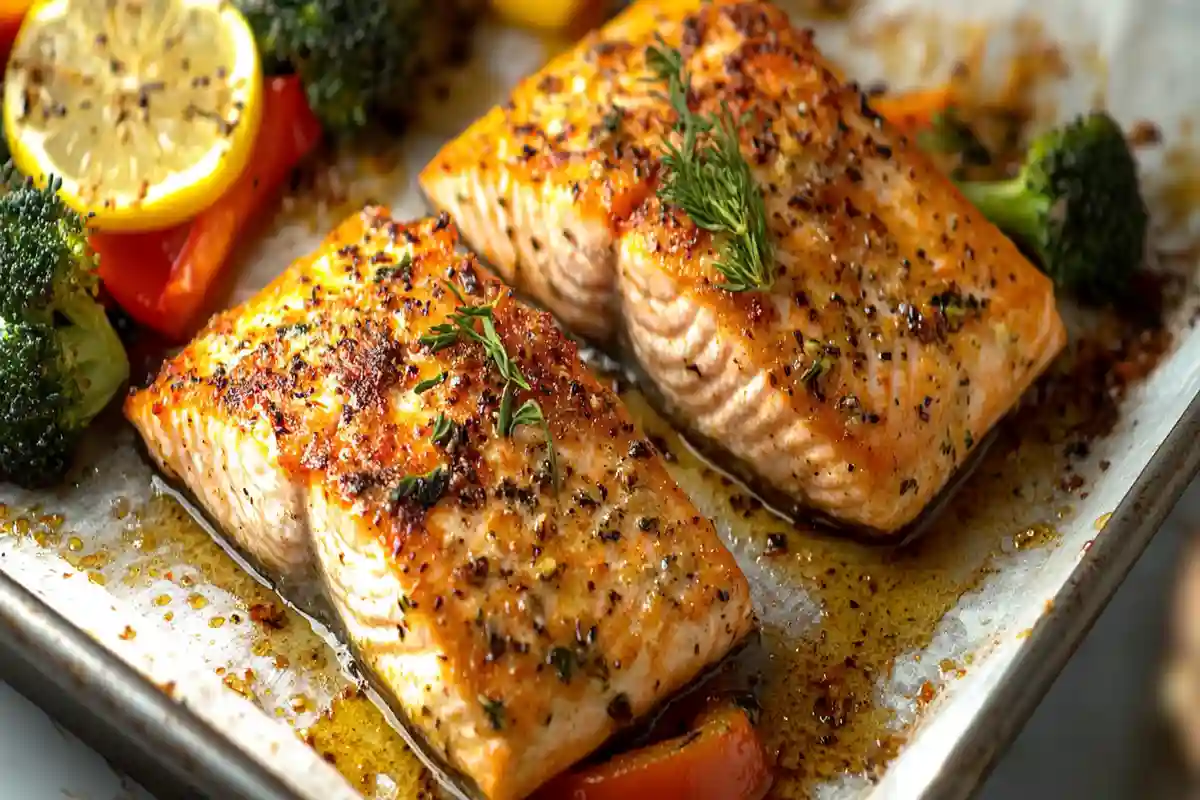Introduction
Anti-inflammatory one-pan dinners are a game changer when it comes to eating healthy without spending hours in the kitchen. Cooking a nutritious meal after a long day can feel like a chore. Between the chopping, the stirring, and the dreaded pile of dishes, it’s tempting to just grab takeout. But what if I told you there’s a way to cook delicious, anti-inflammatory meals with minimal effort and maximum flavor? Enter: one-pan meals.

Now, I know what you might be thinking: “Wait, what’s the deal with anti-inflammatory meals?” Well, here’s the thing—inflammation isn’t always bad. Your body uses it to fight infections and heal wounds. But when inflammation sticks around too long (thanks to processed foods, sugar, and unhealthy fats), it can lead to joint pain, fatigue, bloating, and even chronic illnesses like heart disease and diabetes.
That’s where anti-inflammatory foods come in. They help calm your body down, reducing inflammation naturally. And the best part? You don’t have to spend hours in the kitchen to make them work for you.
What Are Anti-Inflammatory Meals?
Defining Anti-Inflammatory Eating
At its core, an anti-inflammatory one pan helps your body fight off chronic inflammation instead of adding to it. It’s not about following a strict diet—it’s about choosing ingredients that support your health.
These meals focus on whole, unprocessed foods that are rich in antioxidants, healthy fats, and fiber. Think:
- Leafy greens (like spinach and kale)
- Colorful vegetables (bell peppers, carrots, and beets)
- Healthy fats (avocados, nuts, and olive oil)
- Lean proteins (salmon, chicken, and legumes)
- Healing spices (turmeric, ginger, and cinnamon)
What’s missing? Sugar, refined carbs, and processed junk food—all of which can trigger inflammation and cause energy crashes.
Common Anti-Inflammatory Diets
You don’t need to follow a “diet” to eat this way, but anti-inflammatory eating is a core part of some of the healthiest cuisines in the world:
- Mediterranean Diet – Loaded with olive oil, nuts, fish, and fresh veggies, this diet has been linked to better heart health and reduced inflammation.
- Ayurvedic Diet – This ancient Indian approach focuses on warming spices like turmeric and ginger to naturally lower inflammation.
- Japanese & Asian Diets – Rich in fermented foods (kimchi, miso), green tea, and omega-3-rich fish, which all support gut and immune health.
- Indigenous Food Traditions – Many native cultures have relied on whole, plant-based foods, lean proteins, and natural fats for centuries.
Bottom line? Anti-inflammatory eating isn’t a fad—it’s how people have been eating for generations.
Benefits of These Recipes
You’re not just cutting back on inflammation when you eat this way—you’re boosting your entire body. Here’s why these meals are worth adding to your routine:
1. Supports Joint Health
If you deal with stiffness, swelling, or achy joints, these meals can help. Omega-3s (found in salmon, nuts, and seeds) and anti-inflammatory spices work together to reduce pain naturally.
2. Boosts Digestion
Ever feel bloated or sluggish after eating? Refined grains and processed foods can slow your digestion down, while fiber-rich veggies and healthy fats keep things running smoothly.
3. Improves Heart Health
Olive oil, avocados, nuts, and fatty fish have been linked to lower cholesterol and better heart function. Plus, cutting back on inflammatory foods means less strain on your arteries.
4. More Energy, Less Fatigue
Ditch the sugar crashes! Anti-inflammatory meals stabilize blood sugar levels, keeping your energy steady throughout the day.
5. Easy Weight Management
Since these meals focus on nutrient-dense, whole foods, you’ll feel full longer—without counting calories or stressing over portion sizes.
The Magic of One-Pan Meals (Less Work, More Flavor!)
If there’s one thing I love about one-pan meals, it’s that they’re the ultimate “set it and forget it” way to cook. Seriously—there’s no juggling multiple pots, no extra dishes, and no complicated steps. Just throw everything in one pan, let the flavors blend together, and boom—dinner’s done.
And let’s be honest, no one likes standing over the stove for an hour after a long day. One-pan meals give you big, bold flavors with minimal effort, making healthy eating actually sustainable.
Why One-Pan Dinners Are a Game-Changer
So why should you be making these all the time? Here’s why one-pan meals just make sense:
1. Less Cleanup
One pan = one dish to wash. That’s it. No more soaking pots overnight or scrubbing five different pans.
2. Deeper, Richer Flavors
When everything cooks together, the flavors blend beautifully. Your salmon absorbs the garlic, your veggies soak up the olive oil, and those crispy bits on the pan? Pure gold.
3. Hands-Off Cooking
Most one-pan meals require minimal effort. Once you season everything and toss it in the oven (or skillet), your job is basically done.
4. Perfect for Meal Prep
Cook once, eat twice (or three times). One-pan meals store well, so leftovers taste just as good the next day.
Essential Cookware for One-Pan Cooking
To make the most of one-pan meals, having the right pan makes a difference. Here’s what I recommend:
1. Sheet Pans (Best for Roasting)
Great for oven-roasted meals like salmon and veggies, chicken and potatoes, or baked tofu. A heavy-duty, rimmed baking sheet ensures even cooking.
2. Cast-Iron Skillet (Best for Stovetop Meals)
This is a must-have. Cast iron locks in flavor, gives you the perfect sear, and transitions from stovetop to oven seamlessly. Perfect for stir-fries and one-pan pastas.
3. Dutch Oven (Best for Slow-Simmered Dishes)
For meals that need deep, slow-cooked flavors, a Dutch oven is king. Think stews, curries, or even baked casseroles.
4. Non-Stick Saute Pan (Best for Quick Meals)
Ideal for fast, weeknight stir-fries or one-pan grain dishes. Less oil needed, easy to clean, and super versatile.
How to Build the Perfect One-Pan Meal
Making a balanced, anti-inflammatory one-pan meal is simple when you follow this formula:
🥦 Vegetables (Half Your Pan) – Choose colorful, fiber-rich veggies like broccoli, bell peppers, zucchini, or spinach.
🍗 Protein (A Quarter of Your Pan) – Opt for lean proteins like salmon, chicken, chickpeas, or lentils.
🥑 Healthy Fats (A Drizzle) – Extra virgin olive oil, avocado oil, or nuts add richness and boost absorption of nutrients.
🧂 Anti-Inflammatory Spices (A Generous Sprinkle) – Turmeric, garlic, ginger, cumin, and black pepper enhance flavor and fight inflammation.
🍋 Acid for Brightness (A Splash) – Fresh lemon juice, vinegar, or lime takes flavors to the next level.
Now that you’ve got the basics, let’s get to the delicious, easy recipes!
Easy & Delicious Anti-Inflammatory One-Pan Dinners
Now comes the fun part—the recipes! These one-pan meals are packed with flavor, nutrition, and anti-inflammatory benefits, but they don’t require hours in the kitchen. Each one is:
1- Quick to prepare (30 minutes or less)
2- Uses simple, whole ingredients
3- Packed with anti-inflammatory superfoods
1. Sheet Pan Lemon-Garlic Salmon with Roasted Veggies

Why This Recipe Works
- Salmon is rich in omega-3s, which reduce inflammation.
- Broccoli and bell peppers provide antioxidants and fiber.
- Garlic and lemon enhance flavor while boosting immunity.
What You Need (Serves 2-3)
- 2 salmon fillets
- 1 cup broccoli florets
- 1 red bell pepper, sliced
- ½ red onion, sliced
- 2 tbsp extra virgin olive oil
- 3 cloves garlic, minced
- Juice of 1 lemon
- ½ tsp turmeric
- ½ tsp black pepper
- ½ tsp sea salt
How to Make It
- Preheat oven to 400°F (200°C). Line a sheet pan with parchment paper.
- Arrange salmon, broccoli, and bell pepper on the pan.
- Drizzle everything with olive oil, garlic, lemon juice, turmeric, salt, and black pepper.
- Roast for 15-18 minutes until salmon is flaky and veggies are tender.
- Serve warm and enjoy!
2. Turmeric-Spiced Chicken and Quinoa Skillet
Why This Recipe Works
- Chicken is a lean protein that fuels muscle recovery.
- Turmeric, cumin, and ginger fight inflammation.
- Quinoa is rich in fiber and essential amino acids.
What You Need (Serves 3-4)
- 2 boneless, skinless chicken breasts, cubed
- 1 cup cooked quinoa
- 1 zucchini, diced
- 1 bell pepper, chopped
- 1 tbsp extra virgin olive oil
- 1 tsp turmeric
- ½ tsp cumin
- ½ tsp ginger powder
- ½ tsp sea salt
- ½ cup vegetable broth
How to Make It
- Heat olive oil in a large skillet over medium heat.
- Add chicken and cook until golden brown (about 5 minutes).
- Toss in zucchini, bell pepper, and spices. Stir to coat.
- Pour in vegetable broth and simmer for 10 minutes.
- Stir in cooked quinoa and let everything heat through. Serve warm!
3. Mediterranean Chickpea & Spinach Stir-Fry
Why This Recipe Works
- Chickpeas provide plant-based protein and fiber.
- Spinach and tomatoes add essential vitamins and minerals.
- Olive oil and lemon bring out Mediterranean flavors.
What You Need (Serves 2-3)
- 1 can (15 oz) chickpeas, drained and rinsed
- 2 cups fresh spinach
- 1 cup cherry tomatoes, halved
- 1 tbsp extra virgin olive oil
- 2 cloves garlic, minced
- ½ tsp cumin
- Juice of ½ lemon
- ¼ tsp sea salt
How to Make It
- Heat olive oil in a pan over medium heat.
- Add garlic and cumin; sauté for 30 seconds until fragrant.
- Stir in chickpeas and tomatoes. Cook for 5 minutes.
- Add spinach and lemon juice. Cook until spinach wilts.
- Serve warm, and enjoy with brown rice or quinoa!
4. One-Pan Baked Cod with Sweet Potatoes & Kale
Why This Recipe Works
- Cod is a light, lean protein that’s easy to digest.
- Sweet potatoes are packed with fiber and beta-carotene.
- Kale is loaded with antioxidants and vitamin K.
What You Need (Serves 2-3)
- 2 cod fillets
- 1 medium sweet potato, diced
- 2 cups kale, chopped
- 1 tbsp extra virgin olive oil
- ½ tsp paprika
- ½ tsp sea salt
- ½ tsp black pepper
- Juice of ½ lemon
How to Make It
- Preheat oven to 375°F (190°C).
- Toss sweet potatoes with olive oil, paprika, salt, and pepper.
- Spread them on a baking sheet and bake for 10 minutes.
- Add cod fillets and kale to the pan. Drizzle with lemon juice.
- Bake for 15 more minutes, or until cod flakes easily.
5. Spiced Lentil & Vegetable Curry (Vegan-Friendly!)

Why This Recipe Works
- Lentils are packed with plant-based protein and fiber.
- Curry spices (turmeric, ginger, cumin) reduce inflammation.
- Coconut milk adds healthy fats and a creamy texture.
What You Need (Serves 3-4)
- 1 cup dry lentils, rinsed
- 2 cups vegetable broth
- 1 cup diced carrots
- 1 cup diced bell pepper
- 1 can (14 oz) coconut milk
- 1 tbsp olive oil
- 1 tsp turmeric
- ½ tsp cumin
- ½ tsp ginger
- ½ tsp salt
How to Make It
- Heat olive oil in a large pan over medium heat.
- Add carrots and bell pepper; cook for 5 minutes.
- Stir in turmeric, cumin, ginger, and lentils.
- Pour in vegetable broth and coconut milk.
- Simmer for 20 minutes, or until lentils are soft.
- Serve warm with brown rice or quinoa.
Pro Tips for Making One-Pan Meals Even Easier
Now that you’ve got five incredible recipes, let’s talk about how to make them even faster and more efficient. Whether you’re cooking for one, meal prepping for the week, or just trying to spend less time in the kitchen, these tips will make your life a whole lot easier.
Meal Prepping Like a Pro
If you want to make weeknight cooking effortless, prep ahead of time. Here’s how:
– Chop Veggies in Advance – Store pre-cut veggies in airtight containers so they’re ready to toss in the pan.
– Batch-Cook Grains – Make a big batch of quinoa, brown rice, or lentils on Sunday to use throughout the week.
– Marinate Proteins Overnight – Let chicken, salmon, or tofu soak up the flavors overnight for better taste and quicker cooking.
– Use Freezer Packs – Pre-portion all the ingredients for a one-pan meal in a freezer bag. When you’re ready to cook, just dump and go!
Quick Hacks for More Flavor
Healthy doesn’t have to mean boring. Here are simple ways to level up your one-pan meals:
🔥 Toast Your Spices First – Cooking your turmeric, cumin, or paprika in a little oil before adding other ingredients brings out richer flavors.
🍋 Add Acid at the End – A squeeze of lemon or splash of vinegar at the end makes flavors pop.
🌿 Use Fresh Herbs – Chopped cilantro, parsley, or basil brightens up any dish.
🧄 Don’t Skip Garlic & Onions – These natural anti-inflammatories also add a deep, savory taste.
How to Store & Reheat Leftovers
One-pan meals are great for leftovers, but you’ve got to store them right.
🥶 Fridge Storage – Keep leftovers in an airtight container for up to 4 days.
❄️ Freezing – Most meals (except those with leafy greens) freeze well for up to 3 months.
🔥 Reheating – Avoid the microwave when possible. Reheat in a skillet over medium heat with a splash of water or broth to prevent drying out.
Frequently Asked Questions
1. Can I Swap Out Ingredients in These Recipes?
Absolutely! These meals are super flexible. Here’s how to customize them:
- No salmon? Use trout, cod, or chicken instead.
- Don’t like kale? Swap it for spinach, Swiss chard, or arugula.
- Need a plant-based option? Use chickpeas, tofu, or lentils instead of meat.
- Out of quinoa? Brown rice, farro, or whole wheat couscous work too.
The key is to keep the base structure the same: lean protein + healthy fat + fiber-rich veggies + anti-inflammatory spices.
2. How Do I Make These Meals Kid-Friendly?
If you’ve got picky eaters at home, here are a few tricks:
- Dial down the spice – Reduce turmeric, ginger, or cumin if your kids aren’t used to bold flavors.
- Make it fun – Serve meals in wraps, bowls, or with their favorite dips.
- Blend veggies into sauces – Puree roasted peppers or carrots into a sauce for extra nutrition.
- Let them choose toppings – Offer shredded cheese, avocado, or yogurt-based dressings as mix-ins.
3. What’s the Best Oil for Anti-Inflammatory Cooking?
Not all oils are created equal. The best choices for reducing inflammation include:
– Extra Virgin Olive Oil – Rich in antioxidants, great for roasting and sautéing.
– Avocado Oil – Has a high smoke point, perfect for high-heat cooking.
– Coconut Oil – Works well in curries and baking, but use in moderation.
Avoid vegetable oils (corn, soybean, canola) since they can contribute to inflammation.
4. Can I Meal Prep These for the Entire Week?
Yes! Here’s how:
- Cook once, eat twice – Double the recipe and store leftovers for quick lunches.
- Use glass containers – They keep food fresher and don’t absorb odors.
- Reheat properly – A skillet or oven works best to bring back flavor and texture.
5. Do These Recipes Work for Weight Loss?
Yep! Since these meals are high in fiber and protein, they keep you full longer without needing calorie counting. Plus, they help reduce bloating and support digestion.
For weight loss:
- Load up on veggies
- Use lean proteins
- Watch portion sizes for healthy fats like nuts and oils
6. What Are Some Easy Add-Ons to Boost Nutrition?
If you want to supercharge your meals, try adding:
🥑 Avocado – Healthy fats and fiber
🌰 Nuts & Seeds – Omega-3s and crunch
🥒 Fermented Foods – Kimchi, sauerkraut, or miso for gut health
🍋 Citrus Zest – Lemon or lime zest adds antioxidants and brightness
Final Thoughts
Healthy eating doesn’t have to be complicated. With one-pan anti-inflammatory meals, you can make nutrient-packed, flavorful dishes with minimal effort.
If you’re new to anti-inflammatory cooking, start small—pick one recipe this week, test it out, and see how you feel. Once you realize how easy and delicious it is, you’ll want to make these meals a regular part of your routine.

